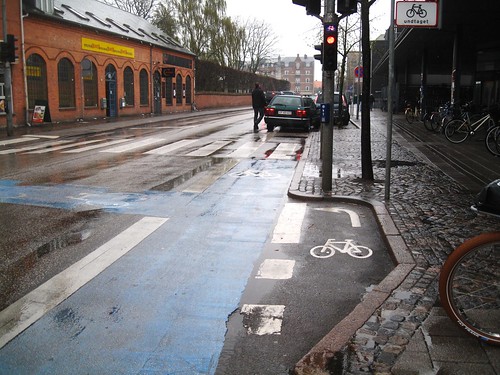
From copenhagenize.com:
This bicycle turn lane is in the Danish city of Roskilde, outside the train station. Like every other Danish city, there are bike lanes. Separated or painted, depending on the traffic volume. Most traffic here continues straight on but there are those who need to turn left. Take out a little piece of sidewalk and wiggle in a turn lane. Sweet.
This one features a button for the cyclist to press when they need to turn. There's no irritating waiting time, it's a quick, efficient process. Perfect for Citizen Cyclists on their way through the town.
6 comments:
Shouldn't a cyclist making a left hand turn move into the left hand turn lane as a car would or move into the lane and signal for a turn. This seems more like treating a bike as a pedestrian and not as a vehicle.
Hi Nathan,
You make a valid point on a relatively contentious issue.
In my opinion, anything that allows more people to feel comfortable cycling on a given road is a good thing.
Besides, I feel as though it is completely logical to treat a bicycle as different from a car, because -- well -- it is.
The Danes are big fans of physically-separating bicycle infrastructure from car infrastructure along high traffic streets. To me, their success is more credible than any of our conventional wisdom about cycling.
It is more of a consistency thing. When I am in a car I expect to see a cyclist acting as a vehicle, a motorcycle is not a car either by the way:). I did not say it should be treated as a car, used vehicle intentionally.
There are many issues with the segregation of bicycles away from normal traffic lanes. What I have seen work best is something like Denver Colorado in the states. they have a combination, dedicated systems of roads/path for bikes, and bike lanes and shared lanes all marked very well. But when on the shared roadways they act as any other vehicle would.
I have not seen any statistics on Denmark. Nor have I ridden there. So I cannot speak to their design.
Hi Nathan,
I agree with consistency; however, I would think that, although this appears inconsistent to you, someone who lives, drives, or cycles in Denmark would find it perfectly expected.
'Car' vs. 'vehicle'. My apologies but my point remains the same: Bicycles are very different than other commonly used vehicles, including motorcycles. Speed, rate of acceleration, size, noise, visibility, necessary road capacity, etc.
Denmark uses an integrated system of off-road trails, physically-separated bike lanes, painted bike lanes, and shared-use, as in Denver.
I see no consistency difference in sometimes having a painted bike lane and sometimes having a painted bike turning area. In both cases, you are separating the bicycle for a reason.
Just as bicycles are given their own lanes when appropriate, bicycles can be given their own context-specific turning lanes. I see this as both logical in terms of safety and efficiency (more visible, not floating in traffic, able to push a button to stop traffic to prioritize cyclists) and in terms of dealing with the sheer number of cyclists that may be present.
For example, on a high-volume street, is it better to cut across one or more lanes of busy vehicular traffic to make a left hand turn, or simply pull into a turning area, press a button, and then make your turn? I am not talking all roads, here, just where it makes sense.
Denver's goal: 10% of commutes by bike by 2018. Copenhagen currently has 55% of city trips by bike.
So, I would lean towards what Copenhagen is doing over what Denver is doing, but that's just me.
Some very good points but there is also the difference in peoples commitment to cars in the 2 locations. Heck there is a difference between Victoria and Copenhagen
I think any solution is a combination and personally I would prefer the vast majority to be bikes and other forms of public transit, but I dream. The key is to keep everyone informed of what all the options are and how they work.
Thanks for the conversation!
Couldn't agree more, Nathan.
There needs to be comprehensive approach that addresses policy and infrastructure. Right now, it is far easier to cycle in Copenhagen than in Victoria; but, it is also easier to cycle in Copenhagen than to drive in Copenhagen.
I think another key is to support every small change that will make cycling more convenient, efficient, or safe, as this will invariably increase cycling and decrease driving.
Thank you, as well. Hope to hear from you, again.
Post a Comment
Two things:
1) A lot of discussion about this site happens on facebook; so, I would recommend finding the site (link on the right sidebar) and me there.
2) I'm experimenting with non-sign-in commenting to encourage more discussion (the 2 minutes it takes to create a google/other account seems like too much trouble).
Being 'anonymous' is pretty lame, so at least make up a fake name to use.